University Project: Technical Roadmap to 100% Renewables in Australia
VerifiedAdded on 2022/11/30
|8
|1627
|222
Project
AI Summary
This project outlines a technical roadmap for Australia to achieve 100% renewable energy across all major sectors, including electricity generation, transportation, heating and cooling, and industrial processes, within 20 years. The roadmap begins with an analysis of the current Australian energy mix, detailing energy consumption patterns and sources, including natural gas, coal, and renewables like hydroelectric power. It then presents a vision for a fully renewable energy economy, emphasizing the utilization of wind and solar resources. Strategies include a nation-building plan involving stakeholder consultations, increased funding, and streamlined approval processes. The roadmap also addresses barriers such as limited funding and recommends market reforms, technological advancements, and research and development in areas such as battery storage and microgrids. The project estimates costs, projects social and economic benefits like job creation, and provides a comprehensive set of references.
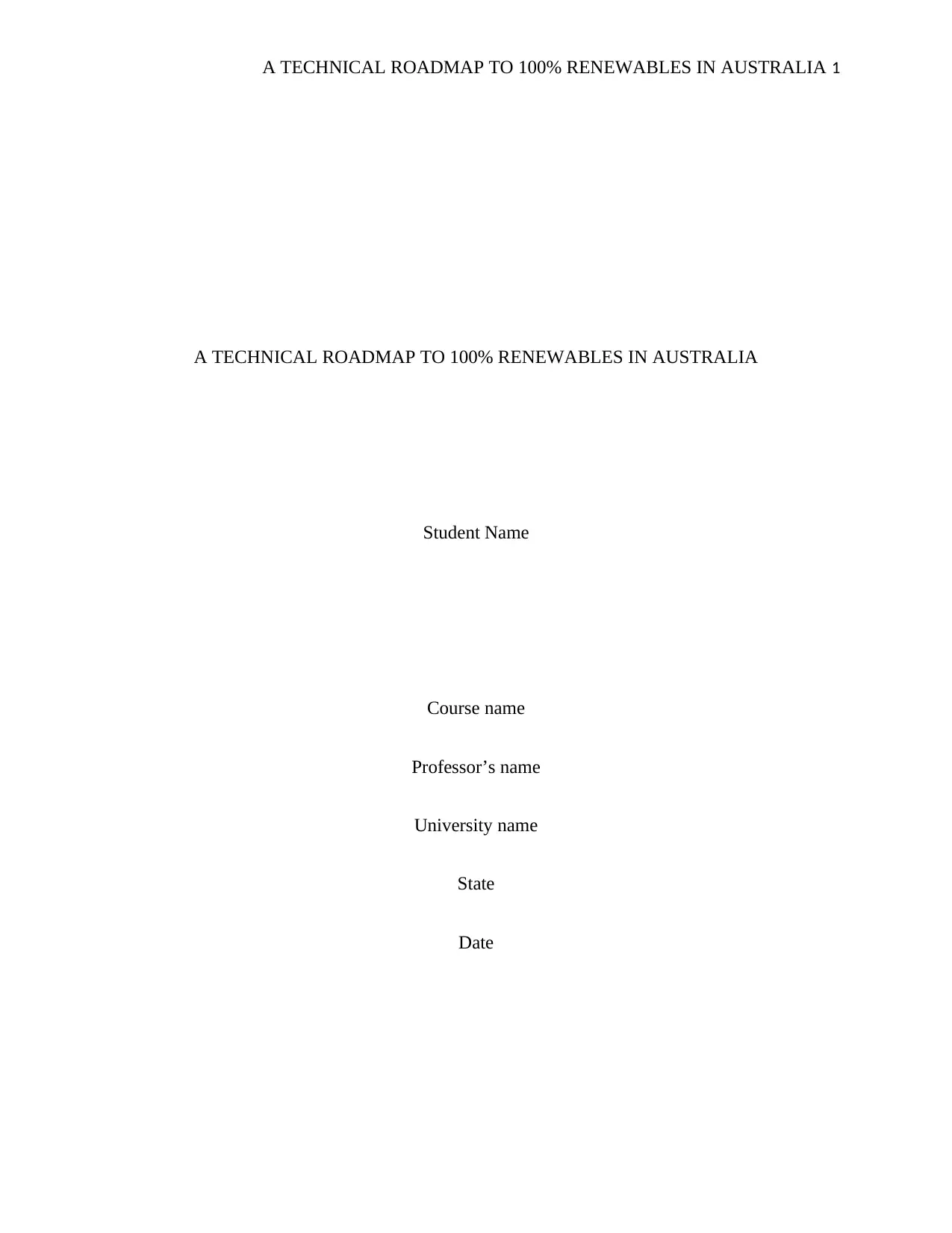
A TECHNICAL ROADMAP TO 100% RENEWABLES IN AUSTRALIA 1
A TECHNICAL ROADMAP TO 100% RENEWABLES IN AUSTRALIA
Student Name
Course name
Professor’s name
University name
State
Date
A TECHNICAL ROADMAP TO 100% RENEWABLES IN AUSTRALIA
Student Name
Course name
Professor’s name
University name
State
Date
Paraphrase This Document
Need a fresh take? Get an instant paraphrase of this document with our AI Paraphraser
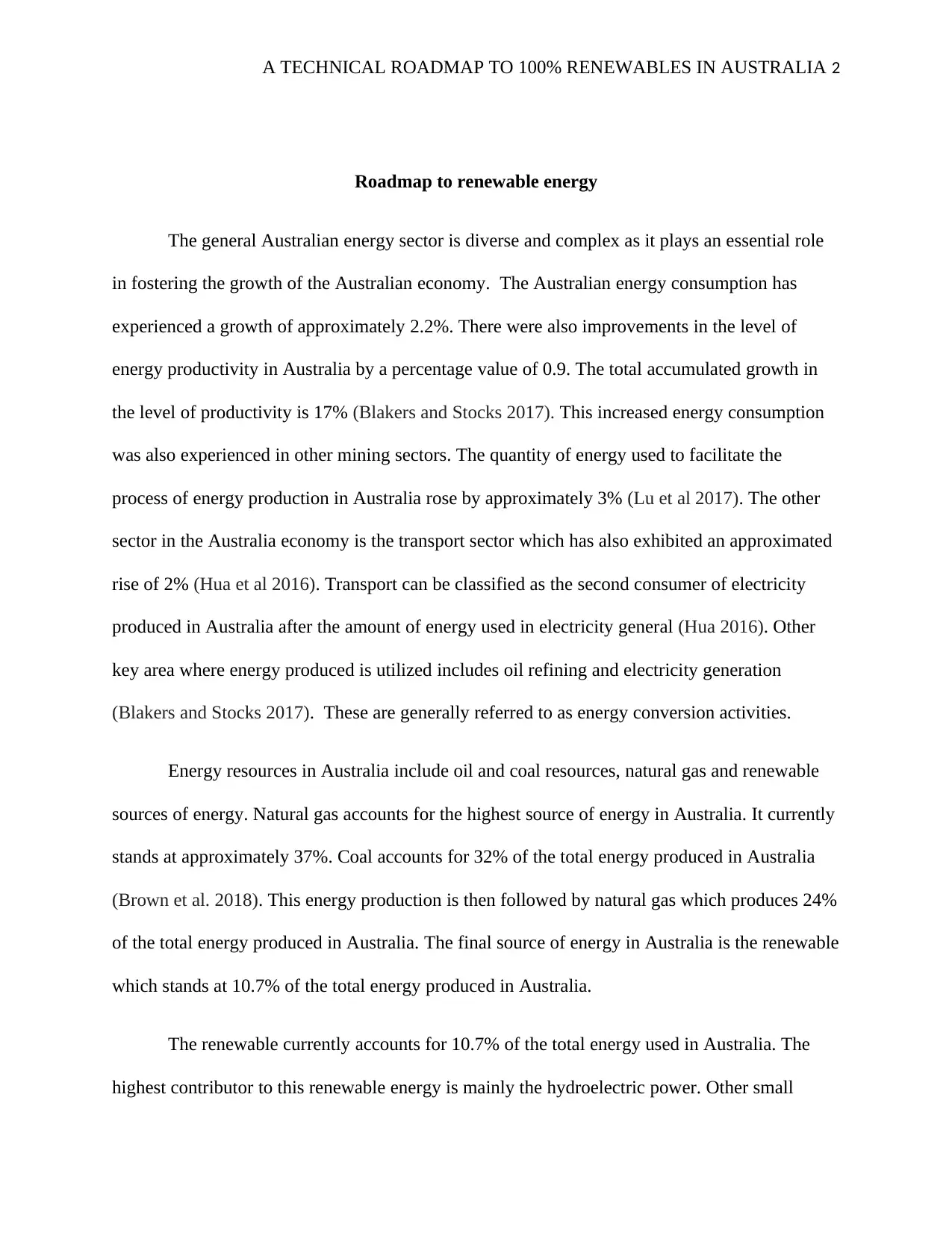
A TECHNICAL ROADMAP TO 100% RENEWABLES IN AUSTRALIA 2
Roadmap to renewable energy
The general Australian energy sector is diverse and complex as it plays an essential role
in fostering the growth of the Australian economy. The Australian energy consumption has
experienced a growth of approximately 2.2%. There were also improvements in the level of
energy productivity in Australia by a percentage value of 0.9. The total accumulated growth in
the level of productivity is 17% (Blakers and Stocks 2017). This increased energy consumption
was also experienced in other mining sectors. The quantity of energy used to facilitate the
process of energy production in Australia rose by approximately 3% (Lu et al 2017). The other
sector in the Australia economy is the transport sector which has also exhibited an approximated
rise of 2% (Hua et al 2016). Transport can be classified as the second consumer of electricity
produced in Australia after the amount of energy used in electricity general (Hua 2016). Other
key area where energy produced is utilized includes oil refining and electricity generation
(Blakers and Stocks 2017). These are generally referred to as energy conversion activities.
Energy resources in Australia include oil and coal resources, natural gas and renewable
sources of energy. Natural gas accounts for the highest source of energy in Australia. It currently
stands at approximately 37%. Coal accounts for 32% of the total energy produced in Australia
(Brown et al. 2018). This energy production is then followed by natural gas which produces 24%
of the total energy produced in Australia. The final source of energy in Australia is the renewable
which stands at 10.7% of the total energy produced in Australia.
The renewable currently accounts for 10.7% of the total energy used in Australia. The
highest contributor to this renewable energy is mainly the hydroelectric power. Other small
Roadmap to renewable energy
The general Australian energy sector is diverse and complex as it plays an essential role
in fostering the growth of the Australian economy. The Australian energy consumption has
experienced a growth of approximately 2.2%. There were also improvements in the level of
energy productivity in Australia by a percentage value of 0.9. The total accumulated growth in
the level of productivity is 17% (Blakers and Stocks 2017). This increased energy consumption
was also experienced in other mining sectors. The quantity of energy used to facilitate the
process of energy production in Australia rose by approximately 3% (Lu et al 2017). The other
sector in the Australia economy is the transport sector which has also exhibited an approximated
rise of 2% (Hua et al 2016). Transport can be classified as the second consumer of electricity
produced in Australia after the amount of energy used in electricity general (Hua 2016). Other
key area where energy produced is utilized includes oil refining and electricity generation
(Blakers and Stocks 2017). These are generally referred to as energy conversion activities.
Energy resources in Australia include oil and coal resources, natural gas and renewable
sources of energy. Natural gas accounts for the highest source of energy in Australia. It currently
stands at approximately 37%. Coal accounts for 32% of the total energy produced in Australia
(Brown et al. 2018). This energy production is then followed by natural gas which produces 24%
of the total energy produced in Australia. The final source of energy in Australia is the renewable
which stands at 10.7% of the total energy produced in Australia.
The renewable currently accounts for 10.7% of the total energy used in Australia. The
highest contributor to this renewable energy is mainly the hydroelectric power. Other small
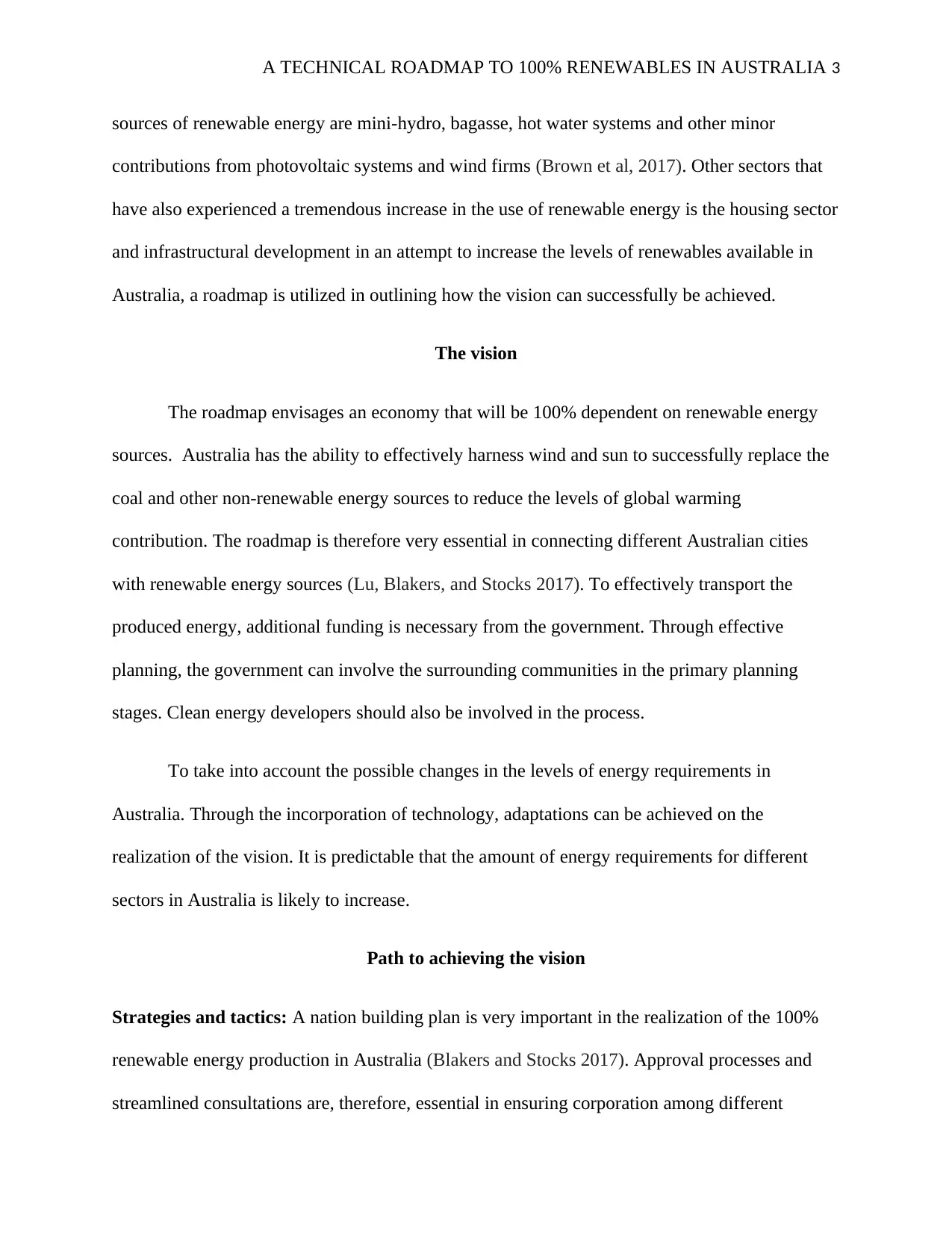
A TECHNICAL ROADMAP TO 100% RENEWABLES IN AUSTRALIA 3
sources of renewable energy are mini-hydro, bagasse, hot water systems and other minor
contributions from photovoltaic systems and wind firms (Brown et al, 2017). Other sectors that
have also experienced a tremendous increase in the use of renewable energy is the housing sector
and infrastructural development in an attempt to increase the levels of renewables available in
Australia, a roadmap is utilized in outlining how the vision can successfully be achieved.
The vision
The roadmap envisages an economy that will be 100% dependent on renewable energy
sources. Australia has the ability to effectively harness wind and sun to successfully replace the
coal and other non-renewable energy sources to reduce the levels of global warming
contribution. The roadmap is therefore very essential in connecting different Australian cities
with renewable energy sources (Lu, Blakers, and Stocks 2017). To effectively transport the
produced energy, additional funding is necessary from the government. Through effective
planning, the government can involve the surrounding communities in the primary planning
stages. Clean energy developers should also be involved in the process.
To take into account the possible changes in the levels of energy requirements in
Australia. Through the incorporation of technology, adaptations can be achieved on the
realization of the vision. It is predictable that the amount of energy requirements for different
sectors in Australia is likely to increase.
Path to achieving the vision
Strategies and tactics: A nation building plan is very important in the realization of the 100%
renewable energy production in Australia (Blakers and Stocks 2017). Approval processes and
streamlined consultations are, therefore, essential in ensuring corporation among different
sources of renewable energy are mini-hydro, bagasse, hot water systems and other minor
contributions from photovoltaic systems and wind firms (Brown et al, 2017). Other sectors that
have also experienced a tremendous increase in the use of renewable energy is the housing sector
and infrastructural development in an attempt to increase the levels of renewables available in
Australia, a roadmap is utilized in outlining how the vision can successfully be achieved.
The vision
The roadmap envisages an economy that will be 100% dependent on renewable energy
sources. Australia has the ability to effectively harness wind and sun to successfully replace the
coal and other non-renewable energy sources to reduce the levels of global warming
contribution. The roadmap is therefore very essential in connecting different Australian cities
with renewable energy sources (Lu, Blakers, and Stocks 2017). To effectively transport the
produced energy, additional funding is necessary from the government. Through effective
planning, the government can involve the surrounding communities in the primary planning
stages. Clean energy developers should also be involved in the process.
To take into account the possible changes in the levels of energy requirements in
Australia. Through the incorporation of technology, adaptations can be achieved on the
realization of the vision. It is predictable that the amount of energy requirements for different
sectors in Australia is likely to increase.
Path to achieving the vision
Strategies and tactics: A nation building plan is very important in the realization of the 100%
renewable energy production in Australia (Blakers and Stocks 2017). Approval processes and
streamlined consultations are, therefore, essential in ensuring corporation among different
⊘ This is a preview!⊘
Do you want full access?
Subscribe today to unlock all pages.

Trusted by 1+ million students worldwide

A TECHNICAL ROADMAP TO 100% RENEWABLES IN AUSTRALIA 4
stakeholders in the energy sector. Other tactics in the realization of the vision involves increased
funding of the Clean Energy Finance Corporation of Australia (Turner, Elliston, and Diesendorf
2013).
Barriers to the realization of the vision: Limited funding from the government is one of the
main barriers to achieving 100% renewable in Australia (Turner, Elliston, and Diesendorf 2013).
As outlined in the roadmap, the vision is quite enormous and therefore requires high more
funding for its realization.
Milestones to the road map: The milestone for the roadmap would include.
o Utilize the available information in mapping the total available resources that can be used
in harnessing renewable energy.
o Involving the community in the planning process, the government and energy developers
are also included in the planning process (Turner and Diesendorf 2013).
o Setting up development zone zones for the renewable energy that have faster approval
processes.
o Linking national energy grid with energy hotspots to allow competitive tenders.
These milestones can be achieved within a span of nine years. The individual stages of the
milestones are achievable in two years.
Recommendations to achieve the vision
One of the recommendations to attain the vision would include the reformation of the
energy market. It is very evident that the current regulations pose high restrictions in the creation
stakeholders in the energy sector. Other tactics in the realization of the vision involves increased
funding of the Clean Energy Finance Corporation of Australia (Turner, Elliston, and Diesendorf
2013).
Barriers to the realization of the vision: Limited funding from the government is one of the
main barriers to achieving 100% renewable in Australia (Turner, Elliston, and Diesendorf 2013).
As outlined in the roadmap, the vision is quite enormous and therefore requires high more
funding for its realization.
Milestones to the road map: The milestone for the roadmap would include.
o Utilize the available information in mapping the total available resources that can be used
in harnessing renewable energy.
o Involving the community in the planning process, the government and energy developers
are also included in the planning process (Turner and Diesendorf 2013).
o Setting up development zone zones for the renewable energy that have faster approval
processes.
o Linking national energy grid with energy hotspots to allow competitive tenders.
These milestones can be achieved within a span of nine years. The individual stages of the
milestones are achievable in two years.
Recommendations to achieve the vision
One of the recommendations to attain the vision would include the reformation of the
energy market. It is very evident that the current regulations pose high restrictions in the creation
Paraphrase This Document
Need a fresh take? Get an instant paraphrase of this document with our AI Paraphraser
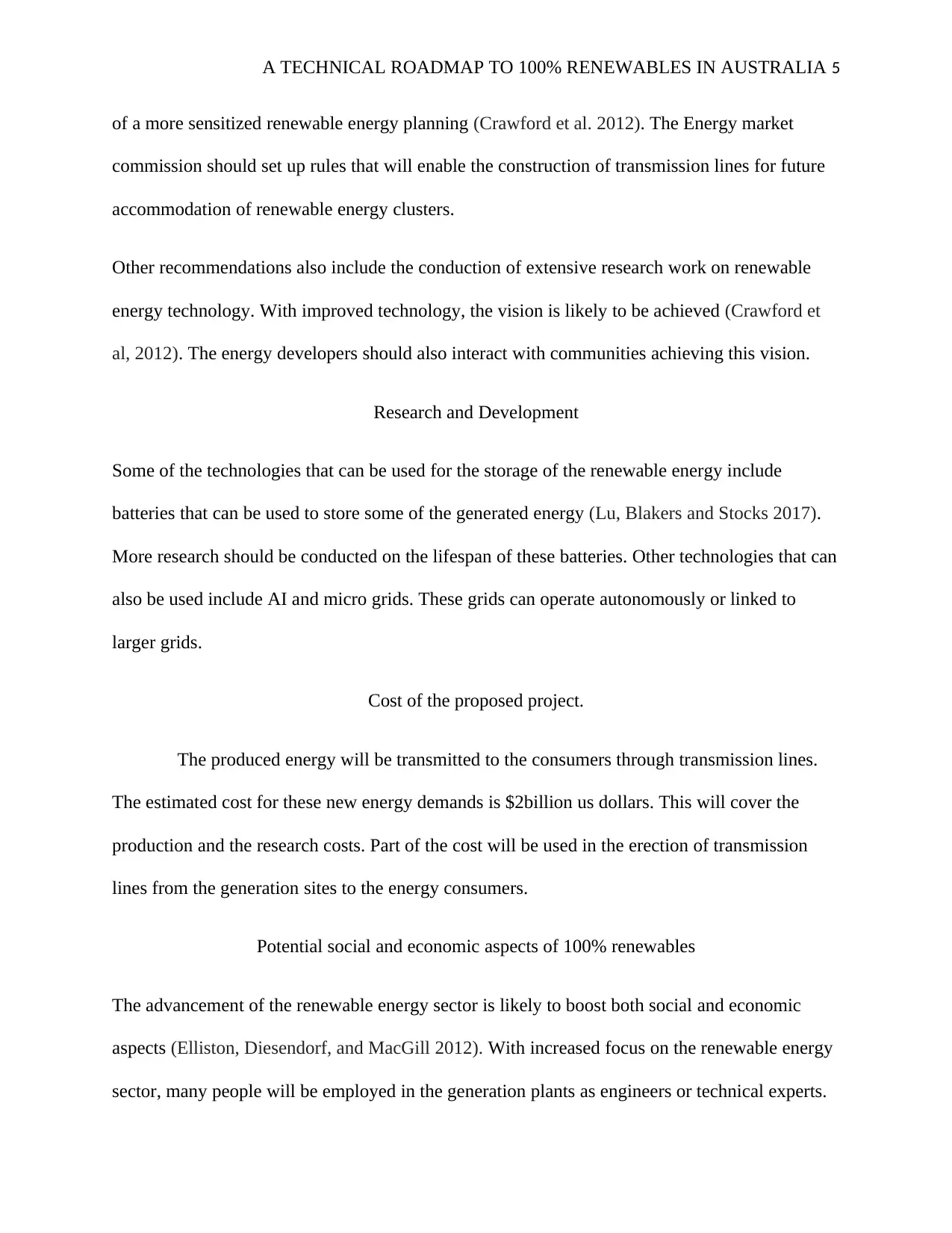
A TECHNICAL ROADMAP TO 100% RENEWABLES IN AUSTRALIA 5
of a more sensitized renewable energy planning (Crawford et al. 2012). The Energy market
commission should set up rules that will enable the construction of transmission lines for future
accommodation of renewable energy clusters.
Other recommendations also include the conduction of extensive research work on renewable
energy technology. With improved technology, the vision is likely to be achieved (Crawford et
al, 2012). The energy developers should also interact with communities achieving this vision.
Research and Development
Some of the technologies that can be used for the storage of the renewable energy include
batteries that can be used to store some of the generated energy (Lu, Blakers and Stocks 2017).
More research should be conducted on the lifespan of these batteries. Other technologies that can
also be used include AI and micro grids. These grids can operate autonomously or linked to
larger grids.
Cost of the proposed project.
The produced energy will be transmitted to the consumers through transmission lines.
The estimated cost for these new energy demands is $2billion us dollars. This will cover the
production and the research costs. Part of the cost will be used in the erection of transmission
lines from the generation sites to the energy consumers.
Potential social and economic aspects of 100% renewables
The advancement of the renewable energy sector is likely to boost both social and economic
aspects (Elliston, Diesendorf, and MacGill 2012). With increased focus on the renewable energy
sector, many people will be employed in the generation plants as engineers or technical experts.
of a more sensitized renewable energy planning (Crawford et al. 2012). The Energy market
commission should set up rules that will enable the construction of transmission lines for future
accommodation of renewable energy clusters.
Other recommendations also include the conduction of extensive research work on renewable
energy technology. With improved technology, the vision is likely to be achieved (Crawford et
al, 2012). The energy developers should also interact with communities achieving this vision.
Research and Development
Some of the technologies that can be used for the storage of the renewable energy include
batteries that can be used to store some of the generated energy (Lu, Blakers and Stocks 2017).
More research should be conducted on the lifespan of these batteries. Other technologies that can
also be used include AI and micro grids. These grids can operate autonomously or linked to
larger grids.
Cost of the proposed project.
The produced energy will be transmitted to the consumers through transmission lines.
The estimated cost for these new energy demands is $2billion us dollars. This will cover the
production and the research costs. Part of the cost will be used in the erection of transmission
lines from the generation sites to the energy consumers.
Potential social and economic aspects of 100% renewables
The advancement of the renewable energy sector is likely to boost both social and economic
aspects (Elliston, Diesendorf, and MacGill 2012). With increased focus on the renewable energy
sector, many people will be employed in the generation plants as engineers or technical experts.
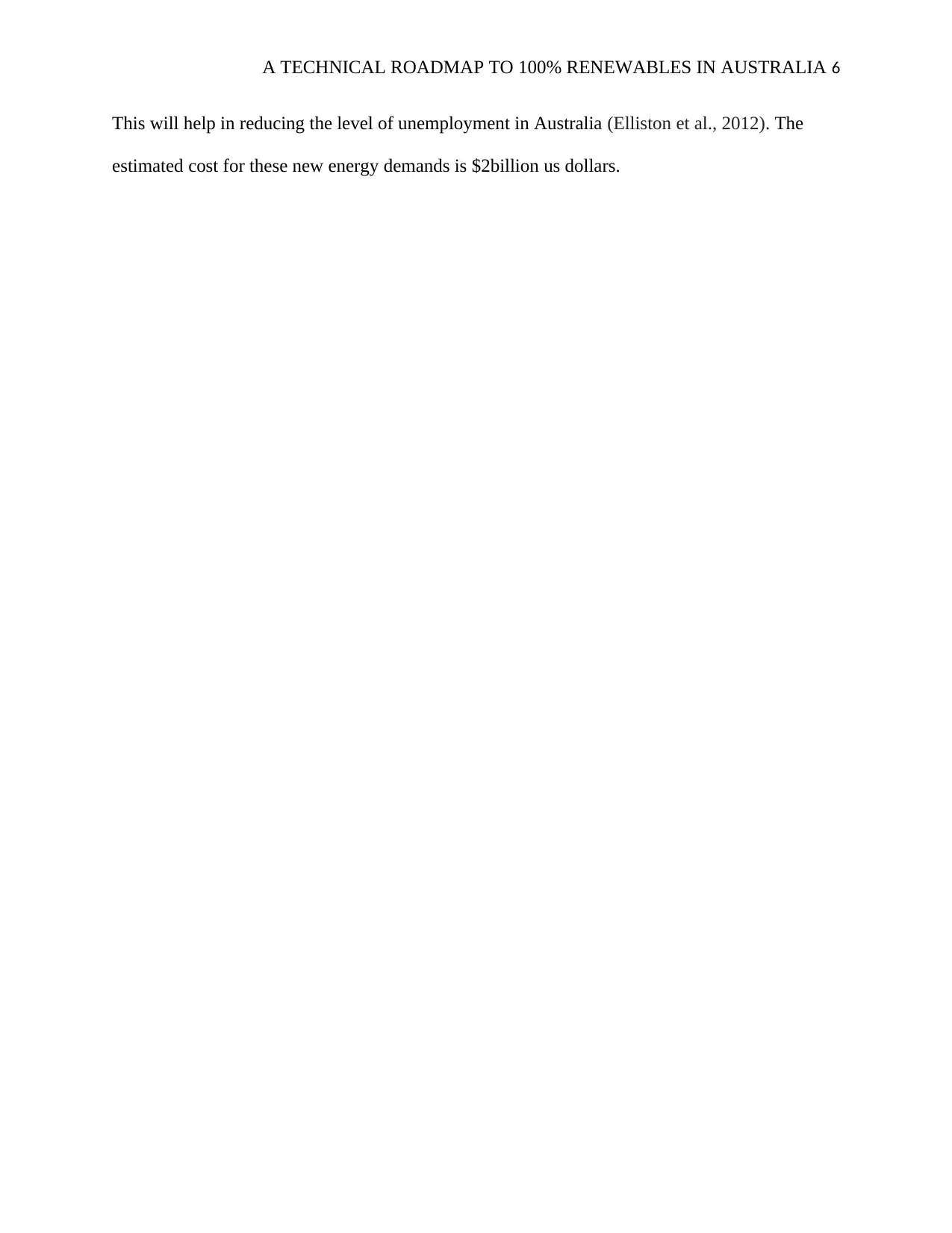
A TECHNICAL ROADMAP TO 100% RENEWABLES IN AUSTRALIA 6
This will help in reducing the level of unemployment in Australia (Elliston et al., 2012). The
estimated cost for these new energy demands is $2billion us dollars.
This will help in reducing the level of unemployment in Australia (Elliston et al., 2012). The
estimated cost for these new energy demands is $2billion us dollars.
⊘ This is a preview!⊘
Do you want full access?
Subscribe today to unlock all pages.

Trusted by 1+ million students worldwide
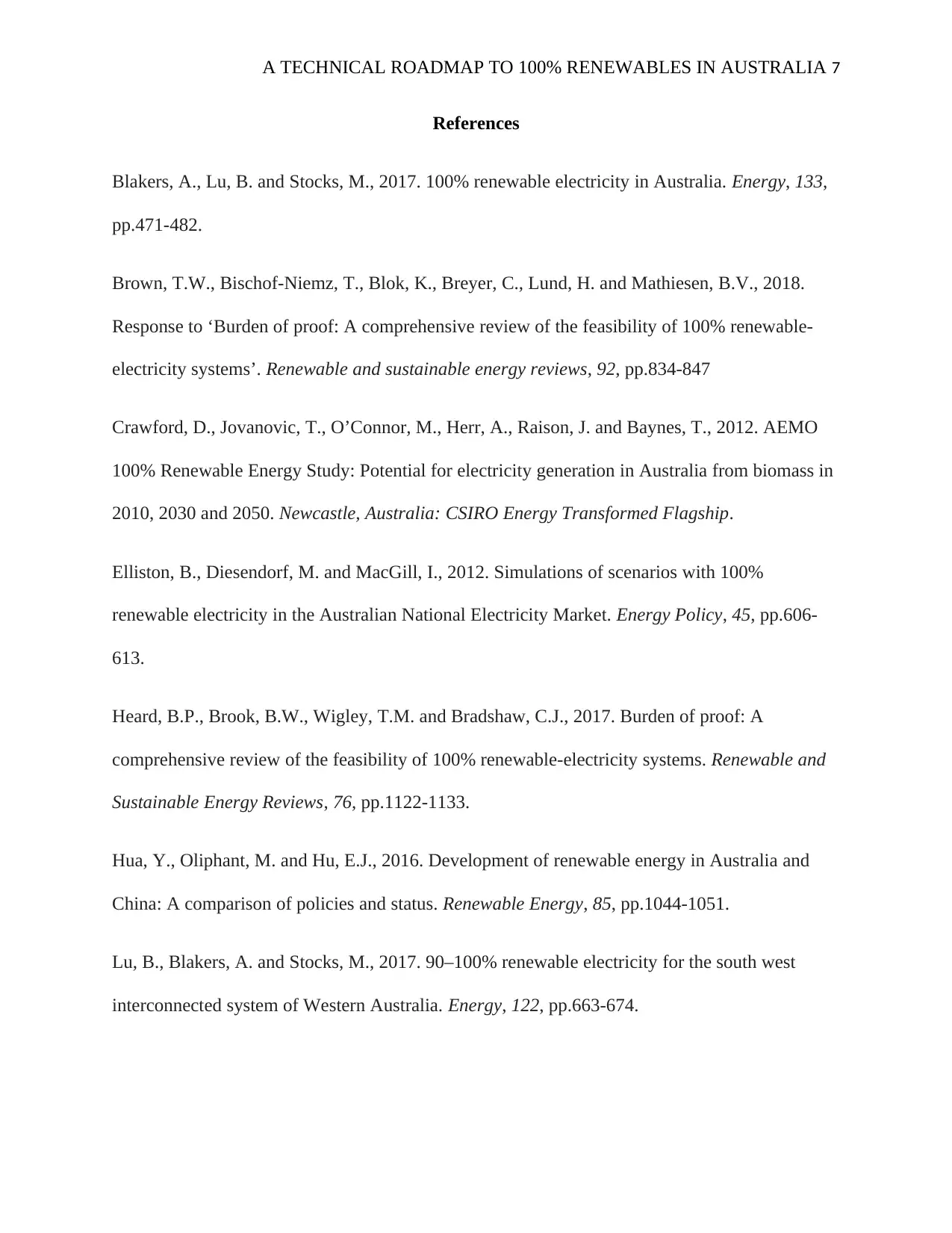
A TECHNICAL ROADMAP TO 100% RENEWABLES IN AUSTRALIA 7
References
Blakers, A., Lu, B. and Stocks, M., 2017. 100% renewable electricity in Australia. Energy, 133,
pp.471-482.
Brown, T.W., Bischof-Niemz, T., Blok, K., Breyer, C., Lund, H. and Mathiesen, B.V., 2018.
Response to ‘Burden of proof: A comprehensive review of the feasibility of 100% renewable-
electricity systems’. Renewable and sustainable energy reviews, 92, pp.834-847
Crawford, D., Jovanovic, T., O’Connor, M., Herr, A., Raison, J. and Baynes, T., 2012. AEMO
100% Renewable Energy Study: Potential for electricity generation in Australia from biomass in
2010, 2030 and 2050. Newcastle, Australia: CSIRO Energy Transformed Flagship.
Elliston, B., Diesendorf, M. and MacGill, I., 2012. Simulations of scenarios with 100%
renewable electricity in the Australian National Electricity Market. Energy Policy, 45, pp.606-
613.
Heard, B.P., Brook, B.W., Wigley, T.M. and Bradshaw, C.J., 2017. Burden of proof: A
comprehensive review of the feasibility of 100% renewable-electricity systems. Renewable and
Sustainable Energy Reviews, 76, pp.1122-1133.
Hua, Y., Oliphant, M. and Hu, E.J., 2016. Development of renewable energy in Australia and
China: A comparison of policies and status. Renewable Energy, 85, pp.1044-1051.
Lu, B., Blakers, A. and Stocks, M., 2017. 90–100% renewable electricity for the south west
interconnected system of Western Australia. Energy, 122, pp.663-674.
References
Blakers, A., Lu, B. and Stocks, M., 2017. 100% renewable electricity in Australia. Energy, 133,
pp.471-482.
Brown, T.W., Bischof-Niemz, T., Blok, K., Breyer, C., Lund, H. and Mathiesen, B.V., 2018.
Response to ‘Burden of proof: A comprehensive review of the feasibility of 100% renewable-
electricity systems’. Renewable and sustainable energy reviews, 92, pp.834-847
Crawford, D., Jovanovic, T., O’Connor, M., Herr, A., Raison, J. and Baynes, T., 2012. AEMO
100% Renewable Energy Study: Potential for electricity generation in Australia from biomass in
2010, 2030 and 2050. Newcastle, Australia: CSIRO Energy Transformed Flagship.
Elliston, B., Diesendorf, M. and MacGill, I., 2012. Simulations of scenarios with 100%
renewable electricity in the Australian National Electricity Market. Energy Policy, 45, pp.606-
613.
Heard, B.P., Brook, B.W., Wigley, T.M. and Bradshaw, C.J., 2017. Burden of proof: A
comprehensive review of the feasibility of 100% renewable-electricity systems. Renewable and
Sustainable Energy Reviews, 76, pp.1122-1133.
Hua, Y., Oliphant, M. and Hu, E.J., 2016. Development of renewable energy in Australia and
China: A comparison of policies and status. Renewable Energy, 85, pp.1044-1051.
Lu, B., Blakers, A. and Stocks, M., 2017. 90–100% renewable electricity for the south west
interconnected system of Western Australia. Energy, 122, pp.663-674.
Paraphrase This Document
Need a fresh take? Get an instant paraphrase of this document with our AI Paraphraser

A TECHNICAL ROADMAP TO 100% RENEWABLES IN AUSTRALIA 8
Turner, G.M., Elliston, B. and Diesendorf, M., 2013. Impacts on the biophysical economy and
environment of a transition to 100% renewable electricity in Australia. Energy policy, 54,
pp.288-299.
.
Turner, G.M., Elliston, B. and Diesendorf, M., 2013. Impacts on the biophysical economy and
environment of a transition to 100% renewable electricity in Australia. Energy policy, 54,
pp.288-299.
.
1 out of 8
Related Documents
Your All-in-One AI-Powered Toolkit for Academic Success.
+13062052269
info@desklib.com
Available 24*7 on WhatsApp / Email
![[object Object]](/_next/static/media/star-bottom.7253800d.svg)
Unlock your academic potential
Copyright © 2020–2025 A2Z Services. All Rights Reserved. Developed and managed by ZUCOL.





